 General
General  General Archive
General Archive  The 100 Best Names in Cleveland Sports History: #25-1
The 100 Best Names in Cleveland Sports History: #25-1
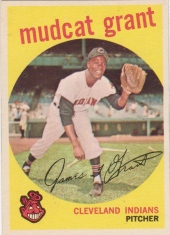 They say the name on the front of the jersey should matter more than the one on the back. But they say a lot of things, don’t they? And they’re quite often wrong. So how about we just ignore them and celebrate the 25 Greatest Names in Cleveland Sports History, instead?
They say the name on the front of the jersey should matter more than the one on the back. But they say a lot of things, don’t they? And they’re quite often wrong. So how about we just ignore them and celebrate the 25 Greatest Names in Cleveland Sports History, instead?
Yes, we’re finally down to the final chapter, the grand finale, the best of the best. It’s time to reveal the 25 pro athletes who signed their unforgettable signatures into the hearts of Cleveland fans forever. Some of them were Hall of Famers, some of them were scrubs, and one of them hasn't even suited up yet. But all of them are mighty fun to namedrop.
100 Best Names in Cleveland Sports History: #100-76 | #75-51 | #50-26 | #25-1
FINAL FACTOIDS ABOUT THE TOP 100
Positions: Out of the top 100 names, the majority were pitchers (19), outfielders (18), wide receivers (8) or NBA guards (8).
Eras: The most represented decades in the list were the 2000s (20), 1970s (19), 1990s (15), 1980s (13), and 1950s (7).
Home States: The leading name-producing states were New York (9), California (8), Texas (8), Florida (8), Georgia (7), and Ohio (6). 14 players were born outside the U.S.
Birthname vs Nickname: Somewhat surprisingly, 64 of the top 100 names were the player’s original birth names.
Hall of Famers: 10 members of the Top 100 are also in their sport’s respective Hall of Fames.
And now... The Top 25!
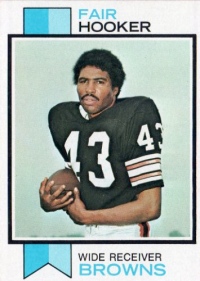 #25 – Fair Hooker
#25 – Fair Hooker
Wide Receiver, Cleveland Browns, 1969-1974
Wide Receiver has always been a personality position. As such, it’s not shocking that five of our Top 25 names are former Browns pass catchers. What is a bit shocking, however, is that there was once a man named Fair Hooker (Fair Hooker, Jr., actually), and that this man played six seasons of professional football. The jokes are obvious enough that uttering them aloud borders on redundancy. Still, you have to love the flexibility in the double entendre, as the “fairness” of the “hooker” in question may refer to anything from her code of ethics to the paleness of her skin to her overall skill set. Or, perhaps she is a fairgrounds attendant by day. It’s a choose-your-own-adventure story, really.
#24 – Gaylord Perry
Starting Pitcher, Cleveland Indians, 1972-1975
It’s appropriate that the man most famous for reviving the spitball also had a name seemingly better suited to the spitball's turn-of-the-century heyday. Gaylord Jackson Perry threw for eight teams across 22 Hall of Fame seasons, but he was at his very best in Cleveland, posting 70 wins, a 2.71 ERA, and 1.10 WHIP across three and a half seasons.
#23 – (Tie) Vic Wertz / Vic Power
First Basemen, Cleveland Indians, 1954-58 (Wertz) / 1958-61 (Power)
They sound like opposing radio frequencies or electrical charges. “When the lever is up, that’s vic wertz. When it’s down, that means you’re at vic power.” The more amusing reality is that Cleveland employed a Vic at first base for eight straight years, with a brief and dangerous double-Vic overlap in 1958. Both Wertz and Power were acquired in June trades (Wertz from Baltimore for Bob Chakales in ’54; Power from the A’s for a kid named Roger Maris in ‘58). Wertz would be best remembered for flying out to Willie Mays that one time, despite two Top-10 MVP seasons in 1955 and ’56. He’d be replaced by Power, who would make two All-Star teams and win three gold gloves during his own brief time in Cleveland. Both men are proof that Victor is a fine starting point for any sports name.
#22 – Colt McCoy
Quarterback, Cleveland Browns, 2010-2013
Daniel Colt McCoy (yes, Colt is sorta technically his real name) may not have led the miserable Browns franchise out of the doldrums as he intended, but the legacy of his name remains. For in the grand history of the National Football League, there may not be a single quarterback with a more presumptuously epic moniker than this one. Not even "Joe Montana" or "Johnny Unitas" sound this damn All-American and tough and folkie and courageous and Christian and ass-kickin' and apple-pickin'. What a tragedy it would be if the NFL equivalent of Indiana Jones winds up nothing more than Brady Quinn, part deux.
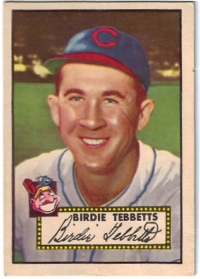 #21 – Birdie Tebbetts
#21 – Birdie Tebbetts
Catcher, Cleveland Indians, 1951-1952
In 1949, a 36 year-old George “Birdie” Tebbetts made the All-Star team and earned MVP votes despite hitting just .270 with 5 HR and 48 RBI for the Red Sox. That explains how well respected he was as a catcher, and why the Indians took a flier on him a year later as an even crustier old vet. Birdie and Jim Hegan would spend the next two seasons catching the fearsome foursome of Lemon, Garcia, Wynn, and Feller. And a decade later, Birdie would post a 278-259 (.518) mark across four seasons as the Tribe’s skipper.
#20 – Jamario Moon
Forward, Cleveland Cavaliers, 2009-2011
The state of Alabama represents once again with the high-flying, big-smiling forward out of the basketball juggernaut known as Meridian Community College. Sure, Jamario’s FG percentage dropped from 46% to 40% after the departure of King Nothing. And yes, he was ushered out of town with Mo Williams and zero remorse back in 2011. But let us recall Mr. Moon as he was in the 2010 playoffs, shooting 58% off the bench and 8 of 16 from three-point range. And let us marvel at the finest lunar-themed moniker since Blue Moon Odom. Or at least Moonunit Zappa.
#19 – Syndric Steptoe
Wide Receiver, Cleveland Browns, 2008
Despite standing a diminutive 5’8”, Syndric Steptoe (of course that's his real name; who could make it up?) put up solid numbers in college at Arizona and was snagged by Cleveland in the 7th round of the ’07 draft. Of course, in college, you only need to step one foot—or toe—in bounds to complete a catch. In the NFL, Steptoe’s adjustment to stepping multiple toes inside the chalk would prove remarkably unfruitful. He was last seen plying his trade for the Edmonton Eskimos, who released him in 2012.
#18 – Napoleon Lajoie
Second Baseman. Cleveland Bronchos/Naps, 1902-1914
As quality names go, it’s mighty difficult to top the honor of having your own team officially named after you. And while the “Naps” wouldn’t have the staying power of Paul Brown’s “Browns,” Nap Lajoie (confirm the pronunciation with your local French teacher) himself would cruise into the Hall of Fame as a giant of the deadball era and one of the greatest second basemen ever. He remains the Indians’ all-time hits leader—100 years later-- with 2,046.
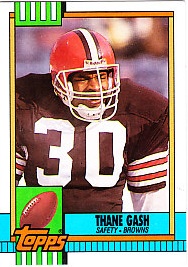 #17 – Thane Gash
#17 – Thane Gash
Safety, Cleveland Browns, 1988-1990
Before Eric Turner or T.J. Ward were goring helpless receivers in the Browns defensive backfield, there was a safety out of Middle Tennessee State whose very name warned of a gruesome fate for any who dared cross his path. He wasn’t anywhere near as talented as those aforementioned DBs, mind you, but Thane Gash certainly sounded terrifying. “How serious is the injury, Doc?” “Very serious. He’s suffered a thane gash-- the worst kind of gash.” Thane also had two sacks and returned two picks for touchdowns in 1989, so that’s a bonus.
#16 – Earthwind Moreland
Defensive Back, Cleveland Browns, 2001
There are lots of ways to pay homage to your favorite ‘70s soul-funk band. Buy a t-shirt, hang up a poster, maybe even go crazy and get a tattoo. Earthwind Moreland’s mom, however, went the extra mile. As a result, her son would enter the NFL with one of the most magnificent sports names of the new century. But when the Georgia-born cornerback failed to make an impact in Cleveland or anywhere else, the explanation was all too clear. He simply lacked the “fire.”
#15 – Milton Bradley
Centerfielder, Cleveland Indians, 2001-2003
One of the great clubhouse cancers of the 21st century, Milton Bradley’s seemingly endless arsenal of childish tantrums has actually made Candyland and Chutes and Ladders a little less enjoyable by association. Still, Bradley’s chuckle-inducing designation isn’t the highest ranking “product placement” name on our list. That individual is still to come.
#14 – Jubilee Dunbar
Wide Receiver, Cleveland Browns, 1974
Now it’s time to revisit those 1974 Cleveland Browns—a truly awful team with the best-named and least skilled receiving corps in the NFL. With most of the passing game built around short routes to the running backs and tight end Milt Morin, Cleveland only had one WR (Steve Holden) reach the 30-catch mark for the season. The rest of the crumbs were spread amongst the likes of Gloster Richardson (9 catches), Dave Sullivan (5), and of course, the legendary tandem of our #25 name Fair Hooker (4) and the incomparable Jubilee Dunbar (6)—a New Orleans native and former Saint who, like Hooker, would vanish into cultdom forever at season’s end.
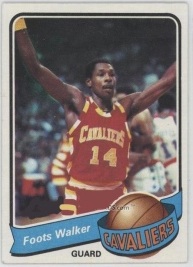 #13 – Foots Walker
#13 – Foots Walker
Guard, Cleveland Cavaliers, 1974-1980
As has already been established, great names were the driving force behind the Miracle of Richfield, and this included the role players. As the team's fleet-footed sparkplug, Clarence “Foots” Walker had himself one of sports’ most ingenious, indisputably flawless nicknames. One can only stand back in awe at its combination of the contextual and the catchy. And Foots was an excellent baller to boot, regularly finishing among the NBA's leaders in steals and assists during his six years in Cleveland.
#12 – Mysterious Walker
Pitcher, Cleveland Naps, 1912
Uh oh, Foots, you’ve got some competition. Unless there’s a Walker out there with the first name “Sleep” or “Imperial,” it’s going to be downright impossible to top the legend of Frederick “Mysterious” Walker. And it really is a legend of sorts. A three-sport star at the University of Chicago, Walker pitched just one game for the Cincinnati Reds in 1910 before resurfacing with the Pacific Coast League’s San Francisco Seals under an assumed name: Frank Mitchell. The questions surrounding this mysterious, dominant hurler (some said he even pitched with a mask on) led to the L.A. Times dubbing him “Mysterious Mitchell”—later amended to “Mysterious Walker” after his true identity was discovered. Of course, that kind of took away the mystery a bit, didn’t it? But I digress. Walker, like so many amazing names from the Cleveland Naps era, had a VERY brief stint in Cleveland—pitching just one inning of one game in 1912. He walked a batter, but escaped unscathed; free to return to the caverns of the Paris Opera House.
#11 – Bingo Smith
Guard/Forward, Cleveland Cavaliers, 1970-1980
Had he remained simply “Robert Smith,” this original Cavalier would have cursed himself to a future of Google search frustration—buried under the wikis of an Ohio State running back and the lead singer of the The Cure. Fortunately, Smith’s sharpshooting ways earned him a new, unique identity that would follow him into the NBA and through a full decade in Cleveland. The Cavs would put together better teams in the ‘80s and the Aughts, but for the kids of the ‘70s, Joe Tait’s calls of “Bingo!” still resonate—having helped to define an upstart franchise.
#10 – Mac Speedie
Wide Receiver, Cleveland Browns, 1946-1952
He’s generally been lost in the shadow of iconic teammates Otto Graham and Marion Motley, but on our list, Mac Speedie (yes, that was his real name) easily trumps them both. Seriously, how does a guy named Speedie become a college track star and All-Pro wide receiver with no sense of irony? Sixty years later, Mac still ranks third in Browns history in both receptions and receiving yards, even though he only appeared in 86 games.
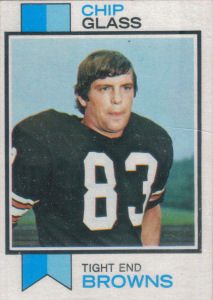 #9 – Chip Glass
#9 – Chip Glass
Tight End, Cleveland Browns, 1969-1973
Despite the fragile sound of his all-time classic nickname, Charles Ferdinand “Chip” Glass was drafted out of Florida State—essentially-- to break other people. This was before players like Kellen Winslow and Ozzie Newsome stuffed the stat sheet and added glamour to the tight end position. In Chip Glass’s day, it was all about blocking and keeping the machine moving. Consequently, he only caught 31 passes and five touchdowns over five seasons in Cleveland, while narrowly missing out on playing alongside Jubilee Dunbar and Fair Hooker on our suddenly much celebrated ’74 Browns team.
#8 – Heathcliff Slocumb
Relief Pitcher, Cleveland Indians, 1993
Most names cannot stand on their own. To worm their way permanently into our brains, they require the complementary memories of the people attached to them—their appearance, personality, accomplishments. This was never the case with Heathcliff Slocumb, however. From the moment we first encountered his name on a baseball card, in a boxscore, or over the airwaves in a slow motion Herb Score utterance, we could never forget it. “His name is Heathcliff Slocumb? For real?” Nevermind that you had an imposing, 6’3” African-American from Jamaica, NY, with a name more suited to a spindly, 19th century British aristocrat or an orange cartoon cat. And ignore the fact that he only spent half a season in Cleveland and went on to much greater success as a closer for the Phillies. For many of us, Heathcliff Slocumb simply set the new standard for where a genuine birth name could go.
#7 – Ben Gay
Running Back, Cleveland Browns, 2001
In the summer of 2001, just days after the Indians had acquired Expos prospect Milton Bradley, the Browns countered by inviting the equally silly-named (and similarly troubled) Ben Gay into training camp. I suppose one could trace the behavioral issues of both Gay and Bradley back to the clear insanity of their parents for naming them as they did. But some curses are a blessing in disguise, as both men made our Top 20! It has to be considered a disappointment, though, that Gay’s NFL career fizzled before he could ink a deal hocking analgesic heat rub. These opportunities don’t present themselves every day.
#6 – Barkevious Mingo
Defensive End, Cleveland Browns, 2013 Draft
And here he is! Out of the 100 players on this list, the newest addition (taken with pick #6 in the 2013 NFL Draft) is also the only one that will play for a Cleveland team in 2013 (presumably anyway). So which obnoxious variation of the LSU star's name will gain the most favor in the Dawg Pound? "Bark Bark Bark Barkevious!"? Or "the Mingo ate your baby!"?
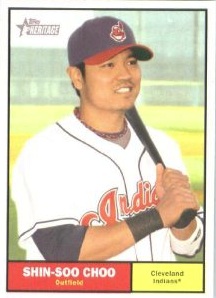 #5 – Shin-Soo Choo
#5 – Shin-Soo Choo
Rightfielder, Cleveland Indians, 2006-2012
All DUI's aside, this recently traded Tribe rightfielder will be sincerely missed now that he's in Cincinnati-- not just for his steady bat, but for the the peppy, sing-songy bliss that came with saying his name. Shin….Soo… Choo! It sounds like the Korean adaptation of those fight scene “Kapow” graphics from the old ‘60s Batman TV series. But it also rhymes! And it’s perfectly crafted for both nicknames (Big League Choo) and stadium chants (“Chooooooooo”). It even sounds like some sort of exotic cooking product from a late night infomercial. “The Shin-Soo Choo truly does it all! But supplies are limited, so call and order yours today.”
#4 – Mudcat Grant
Pitcher, Cleveland Indians, 1958-1964
Jim Grant was a good but not particularly outstanding pitcher for the Tribe in the early ‘60s (67-63, 4.09 ERA, 1.36 WHIP, 5.2 K/9). Mudcat Grant, however, remains a local legend and folk hero. And yes, they are the same person. Grant actually was given the Mudcat moniker by a minor league teammate who had presumed he was from Mississippi. The Floridian embraced it, nonetheless, and the slick nickname earned him almost as much attention as his fast rise through the Indians farm system. In the Bigs by 22, Grant eventually solidified his Cleveland celebrity by working in the Indians’ Community Relations department during the offseason and singing at local jazz clubs with his band “Mudcat and the Kittens.” He also had his own knack for naming things, including his specialty pitches: the “hop and jumper,” the “cloudball,” and the “kickapoo pitch.”
#3 – Webster Slaughter
Wide Receiver, Cleveland Browns, 1986-1991
There’s something magical about an evenly split, four-syllable set of words peppered with both consonance and assonance. It just gives a name a sort of 3-D presence and HD quality. Syndric Steptoe had it. Earthwind Moreland had it. But Webster Slaughter really had it. And when you throw in the connotation of horrific brutality a la Thane Gash, you’ve got the third greatest name in Cleveland sports history. Slaughter was a second round pick out of San Diego State in 1986 and would go on to rack up the 8th most receiving yards in Browns history at 4,834. He was a top target of Bernie Kosar in the glorious Dawg Pound days, and despite persistent rumors, his name was never, in fact, a veiled threat of violence against the pint-sized '80s sitcom star Emmanuel "Webster" Lewis.
#2 – Coco Crisp
Outfielder, Cleveland Indians, 2002-2005
On August 7, 2002, Indians fans did a collective double take as the “player to be named later” in the Chuck Finley trade to St. Louis was finally revealed. His name, apparently, was Coco Crisp, and he immediately became the most talked about member of the Akron Aeros. Born Covelli Loyce Crisp, the speedy outfielder had acquired his nickname from his grandma, who called him “Co” for short. This eventually evolved into “Coco,” as Crisp’s transformation from young man to Kellogg’s breakfast cereal was complete. Unlike a lot of cartoonishly named ballplayers, Coco actually entertained the fans with his skills, as well, tallying 31 homers, 140 RBI, 35 SB, a .299 AVG, and .804 OPS between 2004 and 2005. His trade to Boston the next season wasn’t one of Mark Shapiro’s better ones (Andy Marte, anyone?), but then again, Coco (now in Oakland) has rarely come close to matching his Cleveland production, either.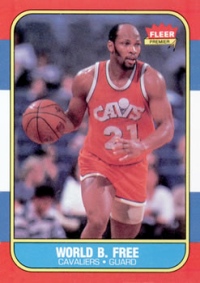
#1 – World B. Free
Guard, Cleveland Cavaliers, 1982-1986
Thirty years before there was a Chad Ochocinco or a Metta World Peace, there was the man atop our list. He was born Lloyd Bernard Free in Atlanta, GA. But it was during his high school days in late '60s Brooklyn, NY, where he first earned the nickname “World.” For many years after, that’s all it was—a nickname. But after breaking out as one of the NBA’s most electric scorers for Philadelphia, San Diego, and Golden State, Free started to take himself, and his unforgettable alter ego, a little more seriously. In 1981, as a member of the Warriors, he had his name legally changed to World B. Free. A year later, he landed in Cleveland, dealt to the Cavaliers for the equally well-traveled Ron Brewer. World, aka the “Prince of Midair,” immediately became the team’s top scorer and a desperately needed ray of sunshine at the end of the disastrous Ted Stepien era. In retrospect, Free was the bridge from the franchise’s roughest period to its competitive rebirth in the 1986 draft. For that alone, we should thank him. His personal flair and 23 points per game were quite admirable, as well. But more than anything, it’s the name we’ll remember. World B. Free—greatest name in Cleveland sports history.
- NBA Announces 2013-2014 Schedule
- Browns Ink Sharknado
- Sharknado A No-Show For Rookie Camp
- Trent Richardson Out Until Training Camp
- Browns Sign Brandon Jackson
- Carrasco Suspended Eight Games
- Browns Add to Wide Receiver Depth with David Nelson
- Browns Need to Learn from Past Draft Mistakes
- Browns Release Chris Gocong and Usama Young
- Browns Missing on Grimes Disappointing, But Not The End
The TCF Forums
- Movies coming out
rebelwithoutaclue (Tuesday, January 21 2014 12:56 PM) - 2015 Recruiting
jclvd_23 (Tuesday, January 21 2014 12:38 PM) - The 2014 Offseason Thread
Larvell Blanks (Tuesday, January 21 2014 12:25 PM) - Official- Browns Coach Search/Rumors
Larvell Blanks (Tuesday, January 21 2014 11:53 AM) - Chris Grant's first 3 drafts
Kingpin74 (Tuesday, January 21 2014 10:13 AM) - Mike Brown
YahooFanChicago (Monday, January 20 2014 11:15 PM) - 2014 Hoops Hockey Hijinx
jpd1224 (Monday, January 20 2014 4:44 PM) - 2014 Recruiting
jclvd_23 (Monday, January 20 2014 2:26 PM) - Wish List - #4 Pick
Hikohadon (Monday, January 20 2014 1:26 PM) - #1 overall pick Anthony Bennett
TouchEmAllTime (Sunday, January 19 2014 1:28 PM)


